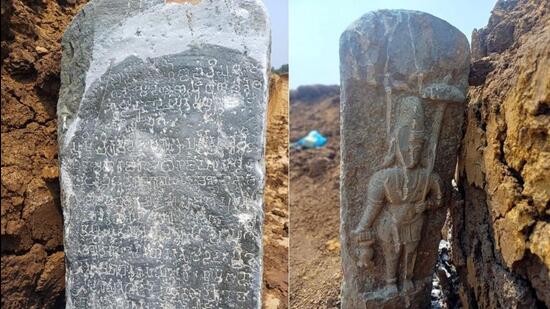Rare 7th-Century Old Kannada Inscription unearthed at Madapura Lake, Karnataka

- 07 May 2025
In News:
A rare 7th-century Old Kannada inscription from the reign of Vikramaditya I of the Badami Chalukyas has been discovered at Madapura Lake in Davangere, Karnataka. The inscription sheds light on taxation, land grants, and regional governance during his rule.
About the Badami Chalukyas
- Origins: Emerged as a regional Kannada power claiming descent from Ayodhya to establish legitimacy.
- Capital:Vatapi (present-day Badami, Karnataka).
- Notable Rulers and Political History:
- Pulakesin I (543–566 CE): Founder of the dynasty; fortified Badami.
- Pulakesin II (609–642 CE): Most celebrated ruler; defeated Harshavardhana at the Narmada river; established diplomatic contacts with Persia (depicted in Ajanta caves).
- Vikramaditya I (644–681 CE): Son of Pulakesin II; reclaimed Badami from Pallavas and expanded influence over southern kingdoms like the Cholas, Pandyas, and Keralas.
- Administration:
- Centralised monarchy with limited autonomy granted to villages.
- Economy relied on land revenue and military conquests.
- Maintained a naval fleet—Pulakesin II had around 100 ships.
- Religion:Patronised Shaivism, Vaishnavism, Shaktism, and Jainism. Vikramaditya I and others made donations to Jain institutions; Pulakesin I performed Ashvamedha Yajna.
- Art and Architecture:
- Developed the Vesara style, a fusion of northern Nagara and southern Dravida temple architecture.
- Constructed rock-cut and structural temples in Aihole, Badami, and Pattadakal.
About Vikramaditya I
- Background: Son of Pulakesin II; ascended the throne during a period of political turmoil following his father's death and Pallava invasion.
- Military Achievements:
- Defeated Narasimhavarman I of the Pallavas, who had earlier seized Badami.
- Reunited the fractured Chalukya empire, restoring its former prestige.
- Subdued southern powers including the Cholas, Pandyas, and Keralas, consolidating control over the southern Deccan.
- Political Consolidation:
- Re-established central authority across Karnataka and surrounding regions.
- Appointed loyal feudatories, such as Singhavenna (mentioned in the new Davangere inscription), to manage local governance.
- Legacy:
- Known by titles such as Rajamalla (King of Kings) and Yuddhamalla (Warrior King).
- His reign marked a revival of Chalukya power and paved the way for cultural and architectural achievements under his successors Vikramaditya II and Kirtivarman II.
